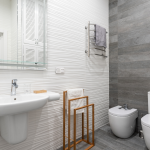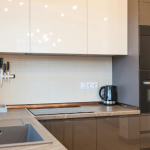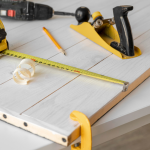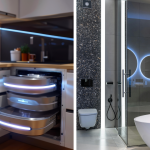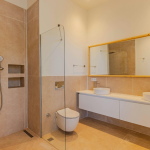Installing underfloor heating in the bathroom is both exciting and discouraging. When you transform your cold, unapproachable bathroom floor into a warm, inviting space, you can greet every morning and evening with warmth and joy. The process, broken down into three manageable steps – the Choosing your heating system , preparing the installation area and laying the heating elements – may seem simple, but it's full of crucial decisions and meticulous tasks.
From accurately measuring your floor space to the final test of your thermostat sensor, every step requires your undivided attention and precision. And while the appeal of reduced energy costs, even heat distribution, and minimal maintenance is strong, the journey isn't always easy. So let's warm up this challenge together and see how we can Bathroom & Kitchen Real Estate Agent and our partners can help you overcome the complexities of this 'hot' topic, so that you are well rested and informed.
Key insights
- Heated floors in the bathroom offer benefits such as Energy efficiency , Added value at the house, Even heat distribution and Minimal maintenance .
- A good Preparation of the installation area is crucial, including accurately measuring the floor, gathering the necessary tools and materials, testing the heating mats under the tiles, and inspecting and cleaning the subfloor.
- In the laying the heating elements is the correct positioning of the thermostat sensor Importantly, performing critical checks and connections, testing the system with an ohmmeter, and connecting to the thermostat while preventing tile gluing during installation.
- It Connecting and testing of the underfloor heating system requires precise weaving and securing of the sensor within the mesh, thorough testing before laying tiles, checking the resistance of the system with an ohmmeter and connecting it to the thermostat.
How do you choose your heating system?
How do you choose your heating system? When selecting your bathroom heating system, it's crucial to weigh the benefits of heated floors, such as energy efficiency and added value to the home, against the specific needs of your project and your DIY skills. Heated floor systems, especially underfloor heating, offer clear benefits such as even heat distribution and minimal maintenance.
The choice between electric underfloor heating, hydronic underfloor heating and systems such as the Etherma Heat Kit depends on your DIY skills and the specifications of your project. Planning the size of the heating cable and layout is essential to ensure that it covers the desired area and matches the included heat kit.
Use a calculator to determine the optimal heating cable size for your space when using systems such as SpeedHeat , Etherma or LKSystems , or go directly to the professionals who will make the necessary installation drawings and find the best installer at the best price, B&K Assembly . They will guarantee technical precision in your installation process.
What is the difference between electrical and hydronic systems?
Here's a simple table that explains the differences:
| Aspect | Electric underfloor heating | Hydronic Underfloor Heating |
|---|---|---|
| Heating method | Uses electrical cables or mats. | Circulates hot water through pipes. |
| Installation | Easier and less costly. Suitable for smaller surfaces and renovations. | More complex and costly. Best for new construction or major renovations. |
| Operational Costs | Higher because of the cost of electricity. Best for small surfaces or short-term heating. | Lower, especially over large areas or for continuous heating. Can integrate with renewable energy. |
| Maintenance | Minimal maintenance required. | May require more maintenance due to the complexity and potential for leaks. |
| Heat distribution and comfort | Quick to heat up and cool down, less uniform over large surfaces. | More consistent and uniform heating, retains heat for longer. |
| Suitability | Ideal for smaller spaces or as supplementary heating. | Preference for large spaces, new construction and where constant heating is needed. |
Preparing the installation area
How do you prepare the installation area? The correct Preparing the installation area is essential for a smooth and efficient installation. Start with the Measuring the bathroom floor to determine the exact area that needs heating. This step is very important for purchasing the right amount of materials.
Then, gather all the necessary tools and materials for the installation process. Before you install anything, test the underfloor heating system to confirm that it is functioning correctly. This precaution prevents future complications. Thoroughly inspect and clean the bathroom subfloor, making sure it is free of debris and moisture. A clean base is vital for a successful installation. Carefully install the heating pipes or mats for under the tiles, being careful not to damage the system during this process.
Laying the heating elements
How do you lay the heating elements? Carefully laying the heating elements under the tiles is very important so as not to damage the system during installation. It is essential to position the sensor for the thermostat in a suitable location and secure it without overlapping with the heating elements. Before you proceed, do a few essential checks and connections:
- Test the underfloor heating system with an ohmmeter to ensure that there are no electrical faults.
- Connect the system to the thermostat , strictly according to local codes and requirements.
- Use mechanical systems to prevent tile elevation during installation , which ensures a smooth, even finish.
- Make sure the sensor is accurately woven into the mesh to avoid interference with the heating elements during the connection and test phase.
Connecting and testing
How do you join and test? Before proceeding, make sure the sensor is accurately woven into the mesh to avoid interference with the heating elements during the connection and testing phase. Position it correctly and secure it within the mesh to accurately measure the floor temperature. You can weave the sensor into the mesh or use hot glue to avoid overlapping with the heating elements.
Test the underfloor heating system thoroughly before laying any tiles, planks or laminate. Use an ohmmeter to check the resistance of the system, and make sure that it is functioning correctly. Finally, connect the underfloor heating system to the thermostat. For the most efficient performance, consider placing it on a separate circuit. This step is very important to ensure that your bathroom underfloor heating works efficiently and safely.

Finishing the floor surface
How do you finish the floor surface? Once you have confirmed that the underfloor heating system is correctly installed and functioning, it is very important to select a finishing floor surface that not only compliments the thermal properties of the system, but also meets the manufacturer's guidelines for a seamless and efficient installation.
- Use a suitable adhesive that is compatible with the heated floor system to ensure a secure connection without endangering the heating elements.
- Follow the manufacturer's installation guide carefully to avoid any damage to the heating system and to comply with the warranty conditions.
- Make sure the finishing surface is properly sealed and assess the thermal properties to maximize heat transfer, which improves both the efficiency and safety of your underfloor heating system.
By paying attention to these technical details, you ensure that the heated floor of your bathroom functions optimally and lasts for years.
Frequently asked questions
How do you install underfloor heating in a bathroom?
To install underfloor heating in your bathroom, start by selecting the suitable system, electric or hydronic. Then, carefully clear the area so that the floor is free of debris. Lay down insulation boards to increase efficiency, then roll out the heating mats or tubes and secure them as directed.
Finally, connect the system to the power supply or boiler, and finish by laying your chosen flooring over the installation, according to the manufacturer's guidelines. Optionally, adding a towel warmer comfort and value. This method offers lower energy costs, minimal maintenance, and increases the value of your home.
What is a basic underfloor heating system?
A basic underfloor heating system involves a series of pipes or electric heating elements that are laid under your bathroom floor. You connect it to the power supply or the hot water system of your house. They spread heat evenly across the surface, so there are no cold spots. It is a simple setup but requires careful planning to avoid damage and ensure efficient operation. You control it via a thermostat, so you can adjust the temperature to your comfort.
Conclusion
Congratulations, you've just embarked on a journey that will transform your bathroom into a cozy paradise. By choosing the right heating system, carefully preparing the installation area, skilfully laying the heating elements and meticulously connecting and testing everything, you are about to achieve the impossible: a piece of heaven under your feet. Finishing the floor space with precision will seal the deal, making your bathroom warm not only your toes but also your heart. Welcome to the future of home comfort, where chilly mornings are a distant memory.


